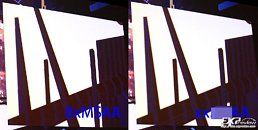Thursday, March 15th 2012

NVIDIA Introducing a New Anti-Aliasing Algorithm with Kepler?
Reliable sources indicate that NVIDIA could introduce a new anti-aliasing (AA) algorithm with its Kepler family of GPUs. There are already plenty of AA algorithms which have been introduced with recent generations of GPUs, including FXAA, which have enabled higher levels of image quality, while not being as taxing as MSAA. This leaves only one area in which a new AA algorithm can take shape: to raise the image quality bar higher, while lowering performance penalty.
In a screenshot, probably sourced from NVIDIA's GeForce Kepler press-deck, this new algorithm is compared to 8x MSAA, in which it appears to give superior image quality. We know that 8x MSAA can be taxing, the kind of image quality we're seeing with this mysterious AA algo 'looks' taxing with available technology, unless of course, NVIDIA developed a silver-bullet in its new algorithm, which provides stunning image quality while not being too taxing on the GPU's resources.
Source:
Expreview BBS
In a screenshot, probably sourced from NVIDIA's GeForce Kepler press-deck, this new algorithm is compared to 8x MSAA, in which it appears to give superior image quality. We know that 8x MSAA can be taxing, the kind of image quality we're seeing with this mysterious AA algo 'looks' taxing with available technology, unless of course, NVIDIA developed a silver-bullet in its new algorithm, which provides stunning image quality while not being too taxing on the GPU's resources.

39 Comments on NVIDIA Introducing a New Anti-Aliasing Algorithm with Kepler?
It looks more like AA off or X2 to me as it is just covered in jagged lines, is it a really big screen or projector and x8AA does not really do anything much once the screen gets that big?
It would be nice to see another new AA that may look better yet not eat up as much power as current ones.
if so, then nvidia did not reveal it at GDC'12 with the Samaritan demo that used FXAA
And NVIDIA's event was on the sidelines of GDC'12, not exactly on the GDC'12 floor, and not every GDC attendee could be there.
ATiAMD. I can't live without AA turned on. Very interested in how this comes out in games I play.so as u said earlier, either it could be an optimised 'temporal AA' (or)
be some kind of 'spin-off' from nvidia's recent research @ SRAA (Subpixel Reconstruction Antialiasing) ? i say spin off because the first letter in the right half of image in the post(with blurred out xx ??AA) does not seem to begin with 'S'.. rather 'M' to me
SRAA was in 2011.. so it could also mean FXAA is a spin off from SRAA research..
Granted I also have a half gig more vram and the game is using most of it (average 1400MB). That was the biggest deciding factor in "upgrading" right now and it has turned out to be definitely a great move.
gets rid of some jaggies while making the image a little blurry
or
gets rid of most jaggies while making the image way blurry
www.anandtech.com/bench/Product/302?vs=309
What is even more shocking is that 1x480 seems to consume more power than 2x6850s..how is that possible?? lol